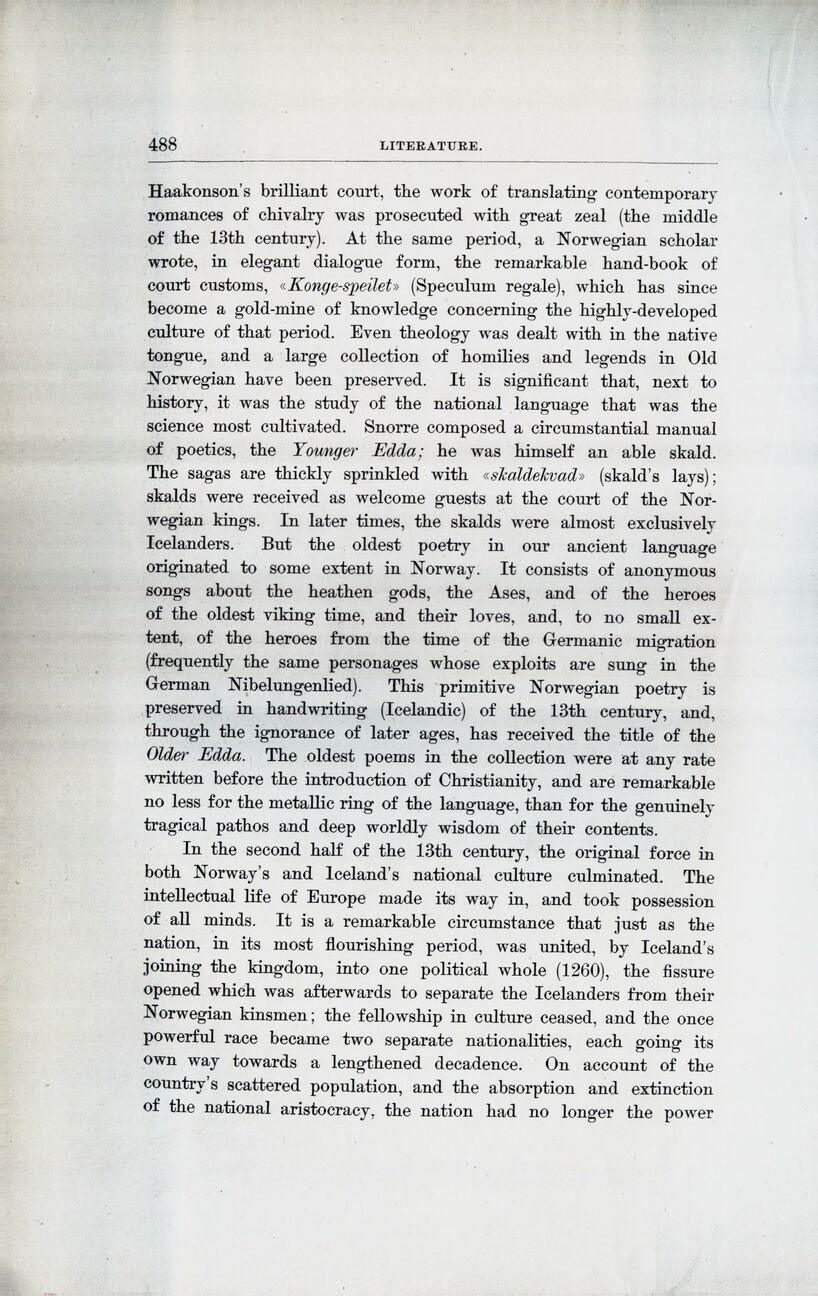
Full resolution (JPEG) - On this page / på denna sida - Literature, by Chr. Brinchmann

<< prev. page << föreg. sida << >> nästa sida >> next page >>
Below is the raw OCR text
from the above scanned image.
Do you see an error? Proofread the page now!
Här nedan syns maskintolkade texten från faksimilbilden ovan.
Ser du något fel? Korrekturläs sidan nu!
This page has been proofread at least once.
(diff)
(history)
Denna sida har korrekturlästs minst en gång.
(skillnad)
(historik)
Haakonson’s brilliant court, the work of translating contemporary
romances of chivalry was prosecuted with great zeal (the middle
of the 13th century). At the same period, a Norwegian scholar
wrote, in elegant dialogue form, the remarkable hand-book of
court customs, «Kongespeilet» (Speculum regale), which has since
become a gold-mine of knowledge concerning the highly-developed
culture of that period. Even theology was dealt with in the native
tongue, and a large collection of homilies and legends in Old
Norwegian have been preserved. It is significant that, next to
history, it was the study of the national language that was the
science most cultivated. Snorre composed a circumstantial manual
of poetics, the Younger Edda; he was himself an able skald.
The sagas are thickly sprinkled with «skaldekvad» (skald’s lays);
skalds were received as welcome guests at the court of the
Norwegian kings. In later times, the skalds were almost exclusively
Icelanders. But the oldest poetry in our ancient language
originated to some extent in Norway. It consists of anonymous
songs about the heathen gods, the Ases, and of the heroes
of the oldest viking time, and their loves, and, to no small
extent, of the heroes from the time of the Germanic migration
(frequently the same personages whose exploits are sung in the
German Nibelungenlied). This primitive Norwegian poetry is
preserved in handwriting (Icelandic) of the 13th century, and,
through the ignorance of later ages, has received the title of the
Older Edda. The oldest poems in the collection were at any rate
written before the introduction of Christianity, and are remarkable
no less for the metallic ring of the language, than for the genuinely
tragical pathos and deep worldly wisdom of their contents.
In the second half of the 13th century, the original force in
both Norway’s and Iceland’s national culture culminated. The
intellectual life of Europe made its way in, and took possession
of all minds. It is a remarkable circumstance that just as the
nation, in its most flourishing period, was united, by Iceland’s
joining the kingdom, into one political whole (1260), the fissure
opened which was afterwards to separate the Icelanders from their
Norwegian kinsmen; the fellowship in culture ceased, and the once
powerful race became two separate nationalities, each going its
own way towards a lengthened decadence. On account of the
country’s scattered population, and the absorption and extinction
of the national aristocracy, the nation had no longer the power
<< prev. page << föreg. sida << >> nästa sida >> next page >>